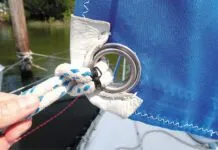Squeaky Bulkhead
I have read with great interest Practical Sailors evaluation of the C&C Landfalls regarding floating bulkheads, which happens to be the cause of my question. I just purchased a 35′ C&C Landfall in St. Petersburg, Florida and sailed it down through the Caribbean, Panama Canal, and up to Costa Rica. The boat performed superbly in all kinds of sea conditions but the squeaking from the bulkheads, even in moderate seas, had the crew wearing earplugs.
Ive been pondering two approaches to the problem. Try and lubricate the bulkhead so that it can move freely without squeaking or try and bond it so it wont move? I am afraid if I choose the wrong path that it may be difficult to reverse my decision. For example, if I inject a bunch of 5200 into the gap I would very likely be committed.
Andy Vickers
Spokane, Washington
For the benefit of our readers, the reason your bulkheads squeak is because they are not bonded to the underside of the deck. Usually this is done with fiberglass tape (precut strips of fiberglass mat or cloth). The veneer on the plywood is cut away to assure good adhesion of the tape to the bulkhead. But when a boatbuilder uses an overhead liner to cover up the rough underside of the deck, it precludes bonding of the bulkheads. As an alternative, those builders may mold in a groove in the overhead liner into which the bulkhead fits. This keeps the bulkhead from moving fore and aft in any gross way, but not from working slightly inside the groove, thereby making squeaking noises.
To minimize this, on our former C&C 33 test boat the builder had screwed a small metal plate to both the bulkhead and liner. Still, the forces that cause a bulkhead to move-rigging and wave loads on the deck and hull-are too powerful to be held in check by tiny screws and plates.
If you could take the deck off and wrap the top of the bulkhead in rubber, that might work, but obviously that isn’t a practical solution. Still, you might be able to wedge some sort of material up into the groove.
Lubricating the wood doesn’t seem either likely to last long, or to be a good idea (why risk the end-grain absorbing a petroleum product?)
You might get temporary relief from forcing an adhesive such as 3M 5200 up inside the groove, though again we worry that eventually the bulkhead will begin to work and move and squeak. Then, as you foresee, youd have a potential mess.
Were it our problem to solve, wed try spraying a Teflon or silicone product into the groove. Like a squeaky door, periodic reapplication will be necessary.
Varnish on Gelcoat
I am repairing, rebuilding and refitting a 37′ Siedelmann. The previous owners varnished the teak trim without taping off the deck or hull and without taking much care with the brush. This has left a lot of varnish on the fiberglass surfaces. What is the best way to remove this varnish without damaging the glass or gelcoat? I will be removing all the trim in question to strip, sand, revarnish and rebed so there will be nothing in the way when I attempt to clean the glass.
Frank Ficken
via e-mail
Yes, varnishing without tape is a bad practice. We don’t know of any cleaner that will work on cured varnish…other than maybe some acids that might be harmful to the gelcoat as well. Weve found that we can chip off varnish with a chisel or sharp knife, and if we are very careful it wont scratch the gelcoat…much! We do a bit every now and then when on the boat with nothing else to do (and when is that?!) It comes off smooth gelcoat fairly easy. The tough areas are the non-skid.
Often we have asked ourselves why varnish disappears so quickly from teak, but manages to last forever on gelcoat? It just aint fair!



































